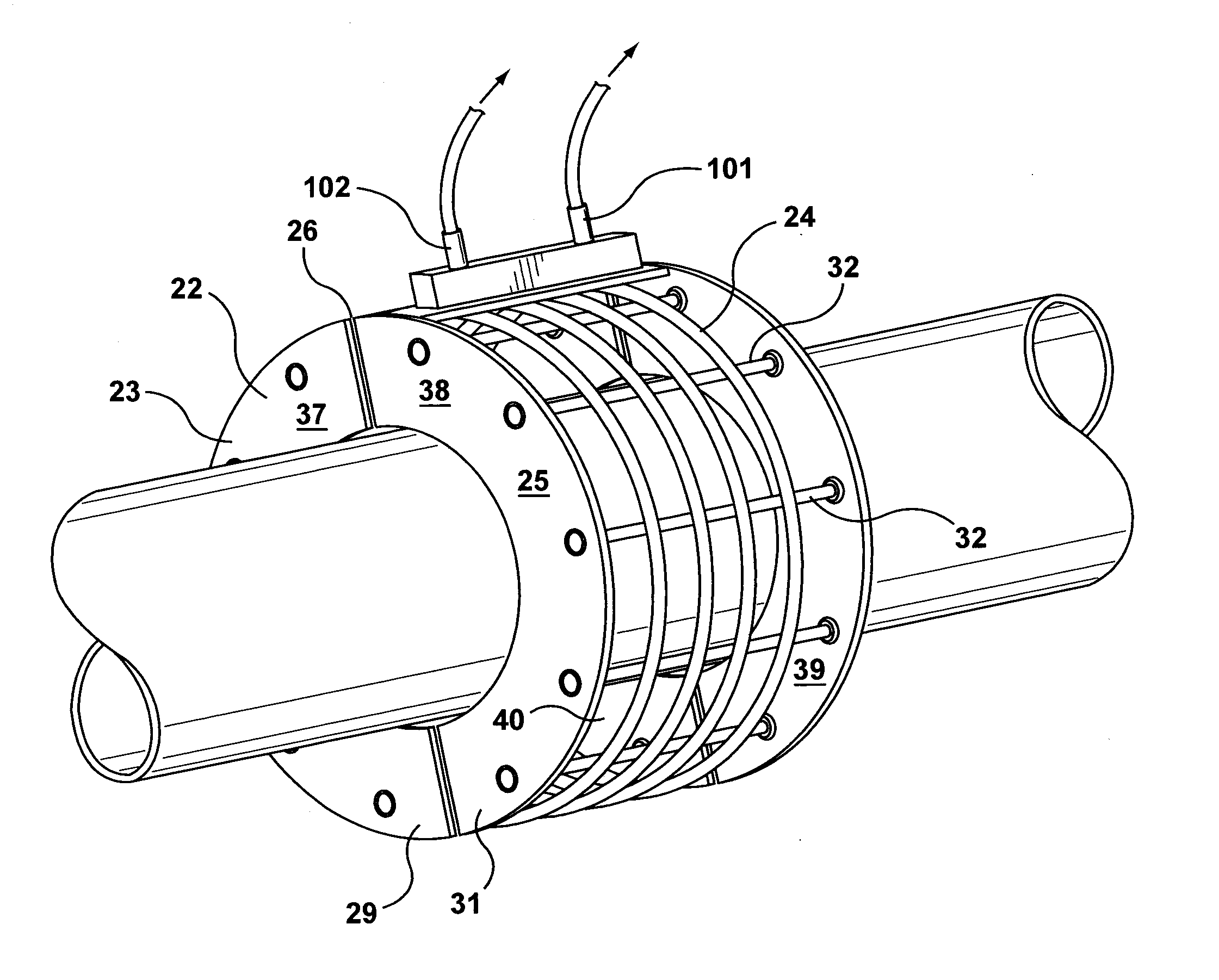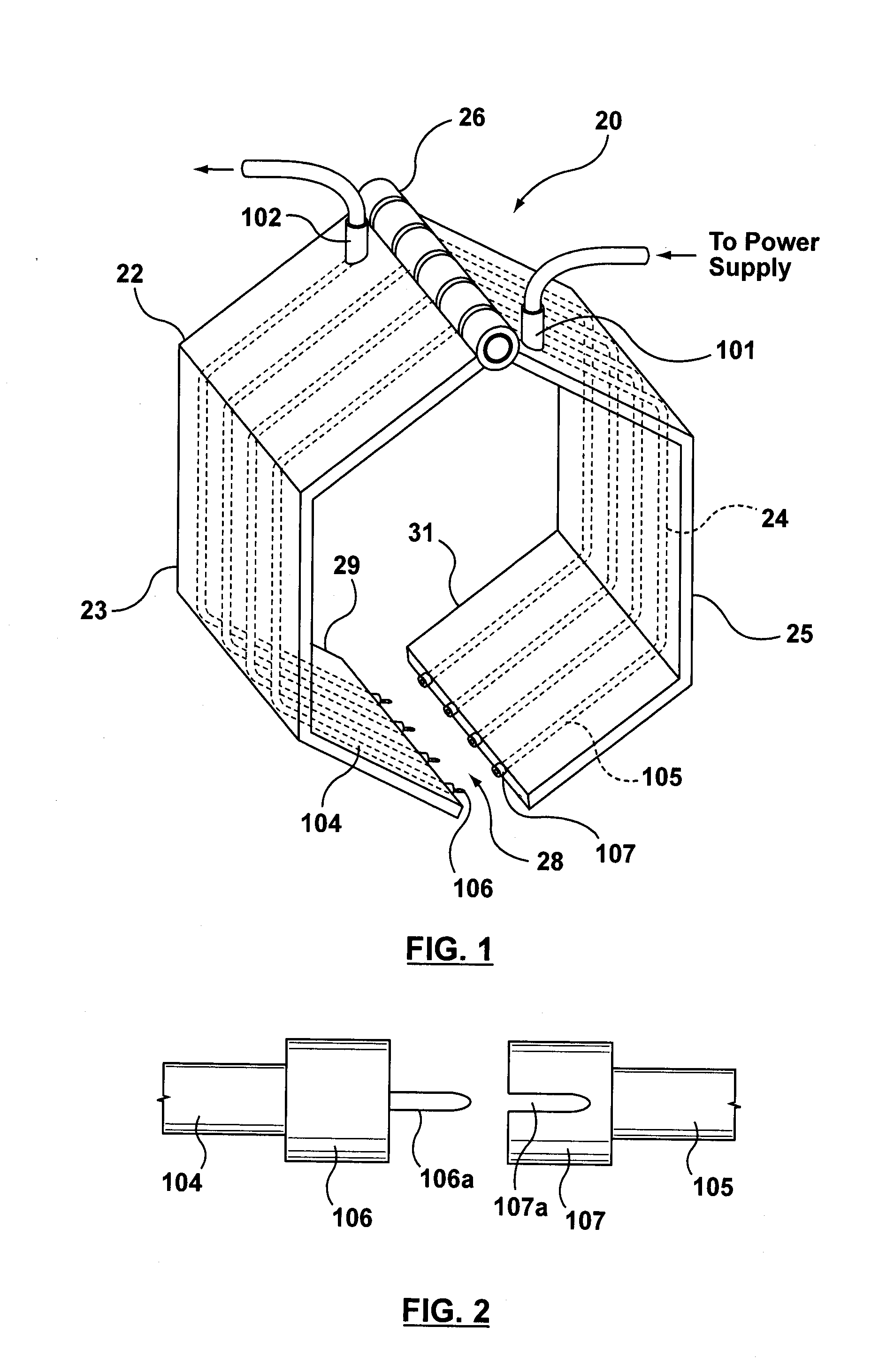Induction heating apparatus for pipeline connections
a technology of induction heating and pipeline connection, which is applied in the field of induction heating apparatus, can solve the problems of affecting the heating effect of the mainline, the deformation of the mainline coating, and the difficulty of heating a 36′′ or a 48′′ pipe with flame, etc., and achieves the effect of convenient flexing, convenient continuous current flow, and low cos
- Summary
- Abstract
- Description
- Claims
- Application Information
AI Technical Summary
Benefits of technology
Problems solved by technology
Method used
Image
Examples
example 1
[0047]To contrast with the 125 Kwatt Tesi induction heating equipment operating at 400 Hz, an experiment was done using a two 30 kw Kwatts Miller units hooked up in series to obtain 60 Kwatts. This generated a frequency of 20,000 Hz. (Miller Electric Mfg. Co., Appleton, Wis. This was powered with a 75 kw diesel generator.
[0048]An induction apparatus with a design configuration according to FIG. 1 was manufactured, and connected to these Miller units.
[0049]The apparatus was used to heat 660 mm diameter pipe with a wall thickness of 30 mm on a joint width of 500 mm. The apparatus took 1.5 minutes to heat the steel from 23° C. to 170° C. In comparison with the traditional induction heating apparatus, this was a quarter of the time than it took with the Tesi 400 hz unit, utilizing half the power.
[0050]In addition, the apparatus had a wire cable of 7 mm in diameter and the entire apparatus, including wire coil and frame, weighed 35 kg. The combined weight of the diesel generator and the ...
example 2
[0051]A pipeline project required a Canusa heat shrink sleeve coating to be applied to the pipe joint on a 84″ diameter pipe. The pipe wall thickness was 50 mm and mainline coating was polyethylene. The exposed steel of the pipe ends was welded together, so that a joint with 300 mm exposed steel was present and the adjacent areas were coated with 5 mm thick polyethylene. The coating to be used was a Canusa GTS-80 sleeve (Shawcor Ltd., Rexdale, Canada) which required a preheat of the joint to 110° C. prior to application of the sleeve.
[0052]First an experiment was done to heat the pipe with 2 torches, each with 200,000 BTU capacity and by two people. It took 22 minutes to heat the joint steel from 23° C. to 110° C. It was determined that it would be difficult to heat such a big pipe by 2 or even 4 people with a torch flame and obtain uniform temperature and in reasonable amount of time. Thus heating of the joint with an induction coil was obviously desirable. However, traditional cla...
example 3
[0055]This experiment was conducted for the application of Canusa HBE liquid epoxy coating onto a pipe joint with a fusion bonded epoxy mainline coating. The installation procedure required the prewarming of the joint to 50° C. to remove the moisture, then application of the liquid epoxy with a roller, and then heating the joint to 95° C. In this application, since there is a wet liquid on the joint, the clam-shell induction coil as shown in FIG. 3 would be quite suitable, since the cables would remain elevated away from the joint surface, and the wet liquid is not disturbed. However, on large diameter pipes, such as 56″ or 84″ pipes, the use of the large clamshell coil would be considered undesirable, especially in rough terrains in the field. An induction blanket solution would be preferable.
[0056]To this end, a joint was prepared in the lab on a 48″ fusion bonded epoxy coated pipe with an exposed steel cutback of 300 mm. The joint was heated to 50° C. with the induction blanket o...
PUM
| Property | Measurement | Unit |
|---|---|---|
| temperature | aaaaa | aaaaa |
| temperature | aaaaa | aaaaa |
| width | aaaaa | aaaaa |
Abstract
Description
Claims
Application Information
 Login to View More
Login to View More - R&D
- Intellectual Property
- Life Sciences
- Materials
- Tech Scout
- Unparalleled Data Quality
- Higher Quality Content
- 60% Fewer Hallucinations
Browse by: Latest US Patents, China's latest patents, Technical Efficacy Thesaurus, Application Domain, Technology Topic, Popular Technical Reports.
© 2025 PatSnap. All rights reserved.Legal|Privacy policy|Modern Slavery Act Transparency Statement|Sitemap|About US| Contact US: help@patsnap.com



